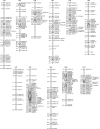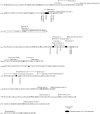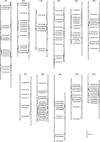The genetics of domestication of rice bean, Vigna umbellata
- PMID: 20880934
- PMCID: PMC2990660
- DOI: 10.1093/aob/mcq188
The genetics of domestication of rice bean, Vigna umbellata
Abstract
Background and aims: The Asian genus Vigna, to which four cultivated species (rice bean, azuki bean, mung bean and black gram) belong, is suitable for comparative genomics. The aims were to construct a genetic linkage map of rice bean, to identify the genomic regions associated with domestication in rice bean, and to compare these regions with those in azuki bean.
Methods: A genetic linkage map was constructed by using simple sequence repeat and amplified fragment length polymorphism markers in the BC(1)F(1) population derived from a cross between cultivated and wild rice bean. Using this map, 31 domestication-related traits were dissected into quantitative trait loci (QTLs). The genetic linkage map and QTLs of rice bean were compared with those of azuki bean.
Key results: A total of 326 markers converged into 11 linkage groups (LGs), corresponding to the haploid number of rice bean chromosomes. The domestication-related traits in rice bean associated with a few major QTLs distributed as clusters on LGs 2, 4 and 7. A high level of co-linearity in marker order between the rice bean and azuki bean linkage maps was observed. Major QTLs in rice bean were found on LG4, whereas major QTLs in azuki bean were found on LG9.
Conclusions: This is the first report of a genetic linkage map and QTLs for domestication-related traits in rice bean. The inheritance of domestication-related traits was so simple that a few major QTLs explained the phenotypic variation between cultivated and wild rice bean. The high level of genomic synteny between rice bean and azuki bean facilitates QTL comparison between species. These results provide a genetic foundation for improvement of rice bean; interchange of major QTLs between rice bean and azuki bean might be useful for broadening the genetic variation of both species.
Figures




Similar articles
-
Construction of genetic linkage map and genome dissection of domestication-related traits of moth bean (Vigna aconitifolia), a legume crop of arid areas.Mol Genet Genomics. 2019 Jun;294(3):621-635. doi: 10.1007/s00438-019-01536-0. Epub 2019 Feb 9. Mol Genet Genomics. 2019. PMID: 30739203
-
Genome dissection of traits related to domestication in azuki bean (Vigna angularis) and comparison with other warm-season legumes.Ann Bot. 2007 Nov;100(5):1053-71. doi: 10.1093/aob/mcm155. Epub 2007 Aug 29. Ann Bot. 2007. PMID: 17728336 Free PMC article.
-
QTL analysis of domestication syndrome in zombi pea (Vigna vexillata), an underutilized legume crop.PLoS One. 2018 Dec 18;13(12):e0200116. doi: 10.1371/journal.pone.0200116. eCollection 2018. PLoS One. 2018. PMID: 30562342 Free PMC article.
-
Vignette of Vigna domestication: From archives to genomics.Front Genet. 2022 Oct 21;13:960200. doi: 10.3389/fgene.2022.960200. eCollection 2022. Front Genet. 2022. PMID: 36338960 Free PMC article. Review.
-
Rice bean: a lesser known pulse with well-recognized potential.Planta. 2019 Sep;250(3):873-890. doi: 10.1007/s00425-019-03196-1. Epub 2019 May 27. Planta. 2019. PMID: 31134340 Review.
Cited by
-
Genetic map of artichoke × wild cardoon: toward a consensus map for Cynara cardunculus.Theor Appl Genet. 2011 Nov;123(7):1215-29. doi: 10.1007/s00122-011-1661-1. Epub 2011 Jul 29. Theor Appl Genet. 2011. PMID: 21800142
-
Pulse-based cropping systems for soil health restoration, resources conservation, and nutritional and environmental security in rainfed agroecosystems.Front Microbiol. 2023 Feb 3;13:1041124. doi: 10.3389/fmicb.2022.1041124. eCollection 2022. Front Microbiol. 2023. PMID: 36817102 Free PMC article. Review.
-
Assessment of the Diuretic Properties of Rice Bean Accessions Using a Mouse Model and Identification of Active Polyphenolic Compounds.Nutrients. 2024 May 24;16(11):1603. doi: 10.3390/nu16111603. Nutrients. 2024. PMID: 38892535 Free PMC article.
-
Transcriptome-wide association mapping provides insights into the genetic basis and candidate genes governing flowering, maturity and seed weight in rice bean (Vigna umbellata).BMC Plant Biol. 2024 May 8;24(1):379. doi: 10.1186/s12870-024-04976-y. BMC Plant Biol. 2024. PMID: 38720284 Free PMC article.
-
Pod shattering in grain legumes: emerging genetic and environment-related patterns.Plant Cell. 2021 Apr 17;33(2):179-199. doi: 10.1093/plcell/koaa025. Plant Cell. 2021. PMID: 33793864 Free PMC article. Review.
References
-
- Ahn CS, Hartmann RW. Interspecific hybridization between rice bean (Vigna umbellata (Thunb.) Ohwi and Ohashi) and azuki bean (V. angularis (Willd.) Ohwi and Ohashi) Journal of the American Society for Horticultural Science. 1978;103:435–438.
-
- Allaby R. Integrating the processes in the evolutionary system of domestication. Journal of Experimental Botany. 2010;61:935–944. - PubMed
-
- Arora RK, Chandel PS, Joshi BS, Pant KC. Rice bean: tribal pulse of Eastern India. Economic Botany. 1980;34:260–263.
-
- Bajracharya J, Singh S, Dangol B, Hollington PA, Witcombe JR. Food security through ricebean research in India and Nepal (FOSRIN). Report 2. Identification of polymorphic markers. Khumaltar, Nepal/Bangor, UK: Agriculture Botany Division, Nepal Agriculture Research Council/CAZS Natural Resources, College of Natural Sciences, Bangor University; 2008.
-
- Bisht IS, Bhat KV, Lakhanpaul S, et al. Diversity and genetic resources of wild Vigna species in India. Genetic Resources and Crop Evolution. 2005;52:53–68.

